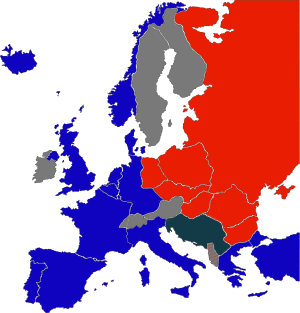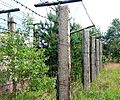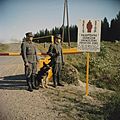Iron Curtain facts for kids

The Iron Curtain was a famous term used during the Cold War. It described the invisible border that divided Europe into two main parts from 1945 until 1991. This division happened after World War II.
On one side were countries connected to the Soviet Union (USSR), mainly in Eastern Europe. On the other side were countries connected to the United States and its allies, mostly in Western Europe. The term "Iron Curtain" showed how the Soviet Union tried to keep itself and its friendly countries separate from the rest of the world. They wanted to limit open contact with Western countries and neutral nations.
Over time, this invisible border also became a real, physical barrier. It was made of fences, walls, minefields, and watchtowers. This barrier stretched for about 7,000 kilometers (4,300 miles) and clearly separated "East" from "West." The famous Berlin Wall was a part of this physical barrier.
Contents
What Countries Were Behind the Iron Curtain?
The countries on the eastern side of the Iron Curtain, influenced by the Soviet Union, included:
The Soviet Union was a very large country made up of many smaller republics. These included Russia, Belarus, Latvia, Ukraine, Estonia, Moldova, Armenia, Azerbaijan, Georgia, Uzbekistan, Kyrgyzstan, Tajikistan, Lithuania, Turkmenistan, and Kazakhstan.
How Did the Iron Curtain End?
The Iron Curtain began to fall apart with peaceful protests in countries like Poland, Hungary, East Germany, Bulgaria, and Czechoslovakia. These events led to the end of communist rule in many places. However, Romania was the only country where the government was overthrown with violence.
Who First Used the Term "Iron Curtain"?
The idea of an "Iron Curtain" as a symbol for strict separation has been around for a long time. It was first used for fireproof curtains in theaters. But it became famous during the Cold War because of a speech given by Winston Churchill.
Churchill was a very famous Prime Minister of the United Kingdom during World War II. On March 5, 1946, he gave a speech in Fulton, Missouri, in the United States. He was invited by the American president at the time, Harry S. Truman.
In his speech, Churchill talked about an "iron curtain" that had fallen across Europe. He meant that the communist countries in the East were hidden and separated from the democratic countries in the West. This speech was seen by Nikita Khrushchev, who later became the leader of the USSR, as a challenge.
What Did "Satellite State" Mean?
When Churchill spoke about the Iron Curtain, he was also talking about "satellite states." A satellite state is a country that is controlled or heavily influenced by a more powerful country. In this case, the Soviet Union controlled countries like Hungary, Poland, Romania, and Bulgaria. Before World War II, some of these countries had been controlled by Germany.
The term "Iron Curtain" showed that what was happening in these satellite states and in the Soviet Union was kept secret from the rest of the world.
Images for kids
More Images of the Iron Curtain
-
Remains of the "iron curtain" in Devínska Nová Ves, Bratislava (Slovakia)
-
Preserved part of "iron curtain" in the Czech Republic. A watchtower, dragon's teeth and electric security fence are visible.
-
Preserved section of the border between East Germany and West Germany called the "Little Berlin Wall" at Mödlareuth
-
Memorial in Budapest reads: "Iron Curtain 1949–1989"
-
Otto von Habsburg, who played a leading role in opening the Iron Curtain
See also
 In Spanish: Cortina de Hierro para niños
In Spanish: Cortina de Hierro para niños


















